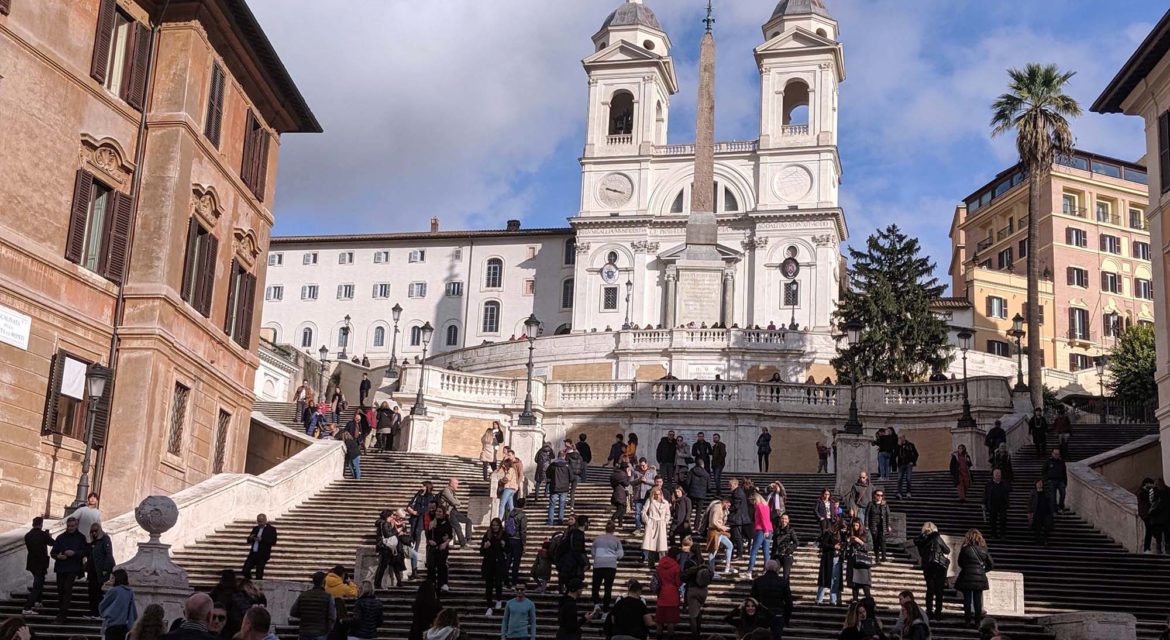 A set of stairs in Rome, Italy has come to do far more than simply link a church with the community beneath it. The Spanish Steps are a monumentous stairway of 135 steps that continue to serve their original purpose of connecting a community while also becoming an attraction that pulls in audiences from all over the world.
A set of stairs in Rome, Italy has come to do far more than simply link a church with the community beneath it. The Spanish Steps are a monumentous stairway of 135 steps that continue to serve their original purpose of connecting a community while also becoming an attraction that pulls in audiences from all over the world.

Linking the Trinità dei Monti Church with the Spanish Square
 The Spanish Steps (Scalina ta di Trinita dei Monti) were designed by the architect Francesco De Sanctis and built between 1723 and 1725. They were constructed to link the Trinità dei Monti church with the Spanish community beneath it. Connecting the areas had been discussed for decades, but a controversy between the Holy See and France about the property of the estate meant that construction of the steps wasn’t completed until 1717.
The Spanish Steps (Scalina ta di Trinita dei Monti) were designed by the architect Francesco De Sanctis and built between 1723 and 1725. They were constructed to link the Trinità dei Monti church with the Spanish community beneath it. Connecting the areas had been discussed for decades, but a controversy between the Holy See and France about the property of the estate meant that construction of the steps wasn’t completed until 1717.
At the bottom end of the stairs is an early baroque fountain called Fontana della Barcaccia, or “Fountain of the Old Boat”. Additionally, the Sallustian Obelisk sits at the top of the Spanish Steps. It is one of the thirteen ancient obelisks of Rome. The obelisk was donated in 1738 to Pope Clement XII by the Ludovisi and later transported to the Lateran before later being erected in front of the church of the Trinità dei Monti in 1788. Various other plaques and dedications are located throughout the area as well.
This history has had a massive impact on the surrounding community, but the simplicity and appeal of the steps and surroundings themselves have also helped to attract audiences from all over the world.

Connecting Communities in Rome and Across the World
 Climbing the Spanish Steps has become a tradition for many tourists and the view it offers them is worth the effort to ascend the 135 steps. The view down to the surrounding neighborhood can take visitors back to another, which is just one of the reasons the Spanish Steps are a popular tour stop for various tours and appear on numerous items for sale throughout the city.
Climbing the Spanish Steps has become a tradition for many tourists and the view it offers them is worth the effort to ascend the 135 steps. The view down to the surrounding neighborhood can take visitors back to another, which is just one of the reasons the Spanish Steps are a popular tour stop for various tours and appear on numerous items for sale throughout the city.
Restaurants that overlook the space have also become incredibly popular spots for residents and visitors. Numerous other businesses fill the square beneath the Spanish Steps that thrive on the crowds that visit the space daily. Additionally, the unique design of the Spanish Steps has made them a popular place for artists, painters and poets. This attraction saw the Spanish Steps become a popular meeting place when they were first created and that same appeal has carried over into the modern-day.
There are other notable examples of how the Spanish Steps have provided a means of connection to the local community. An Italian artist covered the Spanish Steps with hundreds of thousands of multicolored plastic balls. He claimed it was done as a protest against the living conditions of artists in Italy. Many people collected some of the balls and took them away as an “unforgettable souvenir of this event” that compelled feedback from every corner of the surrounding community.
The popularity of the Spanish Steps is part of the reason that regulation bans people from eating, lying down, or even sitting on Rome’s monuments. This popularity underscores how something as simple as a staircase can come to mean something so much more to a city and nation.
From Stairway to Icon
 Numerous icons have started out as a mere means of transportation and come to represent something so much more for their communities. While the Spanish Steps were simply a way to link a church to a community, doing so with a focus on the form and function of those stairs allowed them to become icons on the level of other famous Roman monuments that represent something much more profound for the community and beyond.
Numerous icons have started out as a mere means of transportation and come to represent something so much more for their communities. While the Spanish Steps were simply a way to link a church to a community, doing so with a focus on the form and function of those stairs allowed them to become icons on the level of other famous Roman monuments that represent something much more profound for the community and beyond.


